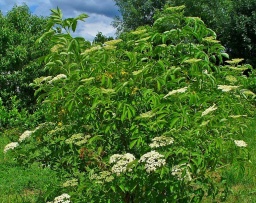


Elderberry
Elderberry, Sambucus canadensis, is a native thicket-forming shrub or small tree that can be found along streams, marshes, and moist forests. It may grow 2-3 m tall (9 to 12 feet), is somewhat woody and has an arching spreading form. Small white flowers are borne in dense clusters. Flowers are followed by drooping clusters of black fruit in late summer to fall.
The elderberry tolerates a wide variety of wet to somewhat dry soils but prefers rich, moist, slightly acid soil in sun to partial shade. Under cultivation, it is tolerant to a wide range of soil conditions but grows best on well-drained loam soils. It is hardy from zone 3-8.
Elderberry is famous as a medicinal berry high in vitamin C, fiber and very high in antioxidants. Elderberries are best cooked into desserts, pies, and jams. It must be cooked to be edible. Eaten raw, berries can cause intestinal discomfort.
‘Adams’ fruits are very large. They are also borne on large clusters up to 15 cm across. Adams compliments Johns Elderberry in pollination. The fruits ripen late in the season and can be harvested over a four week season. Stems grow to eight feet and are well branched. Hardiness Zones 3-8.
‘Johns’ is a named cultivar known for its larger fruits with clusters; at minimum 14cm (5") in diameter. Plants are vigorous, growing 3 m (10') tall. Needs one other Elderberry to pollinate twelve Johns. Hardiness Zones 4a-8a.
'Kent' Elderberry is a large variety of Sambucus canadensis that can produce multiple clusters of small but very sweet Elderberries. This variety is known for its very early season production of berries.
'York' elderberry bush is the largest variety of Elderberry that can produces multiple clusters of large Elderberries. This variety is known for its huge production of large berries, but not necessarily the sweetest. Great for baking. Hardy for zone 3-8.







